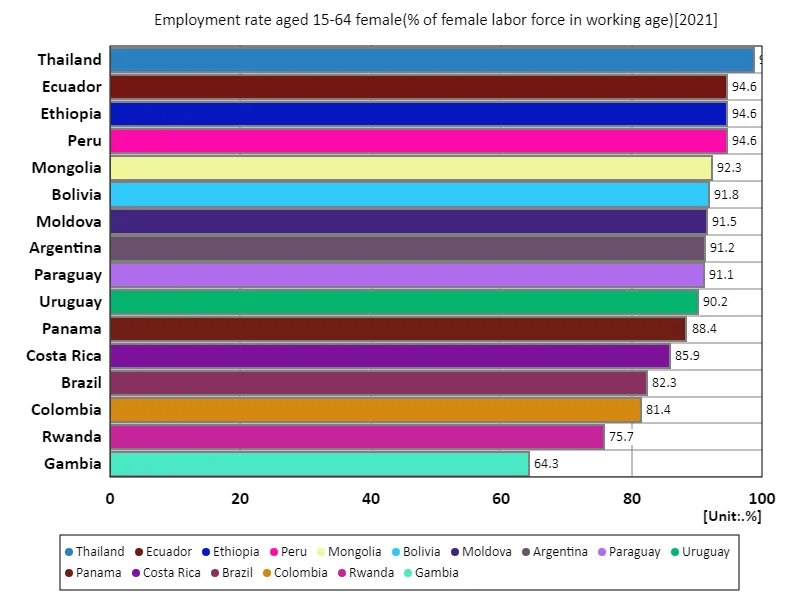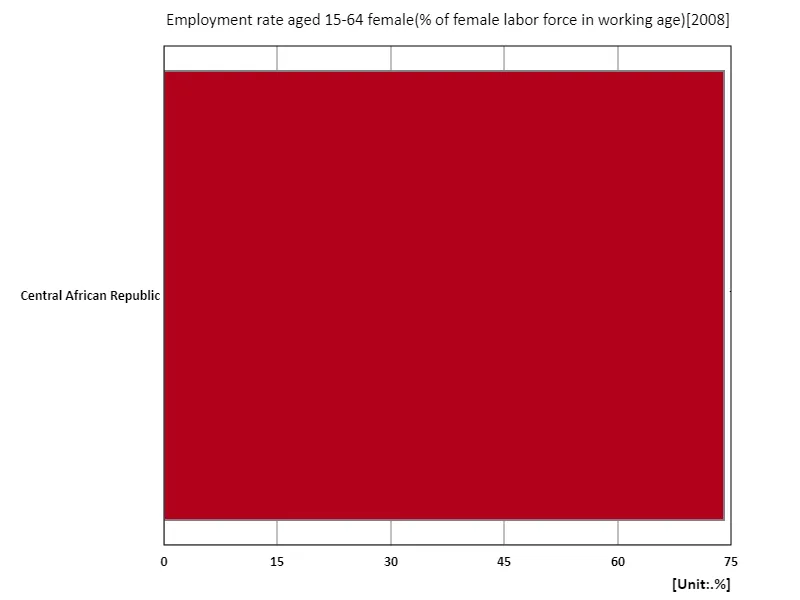- Abstract
- Employment rate of women aged 15-64 (percentage of total female labor force)
- Employment rate of women aged 15-64 (percentage of total female labor force) (worldwide)
- Employment rate of women aged 15-64 (percentage of total female labor force) (worldwide, latest year)
- Employment rate of women aged 15-64 (% of total female labor force) (region, latest year)
- Reference
Abstract
The employment rate of women aged 15 to 64 in Thailand is high at 98.8% in 2021, as more women are entering the labor market along with economic growth. Thailand has a relatively open labour market, providing ample employment opportunities for women. A trend to date has been that the educational levels of women in Thailand are improving and their range of career choices is expanding. Additionally, there is a trend for many women to go out to work to supplement their household income. However, a high employment rate does not necessarily mean high wages or working conditions, and issues such as uneven distribution of jobs and wage disparities remain. Overall, while Thailand’s high employment rate indicates women’s advancement in society, efforts to improve quality will be needed in the future.
Employment rate of women aged 15-64 (percentage of total female labor force)
Looking at data on employment rates for women aged 15-64 (as a percentage of the total female labor force) from 1981 to 2021, several important trends emerge. Of particular note is that Thailand’s employment rate was the highest in the world in 1997, at 99.7%. Thailand’s employment rate has since declined slightly, to 99% in 2021, but still remains at a very high level. This high peak employment rate reflects Thailand’s economic growth and women’s active participation in the labour market. In Thailand, rapid economic development and urbanization since the 1980s have encouraged women to enter the labor market. Additionally, rising educational standards and an increase in career options for women have also contributed to the high employment rate. On the other hand, a high employment rate does not necessarily mean improved working conditions or wages, and wage gaps and working environment issues remain in Thailand. Overall, Thailand’s high employment rate indicates women’s advancement in society, but going forward, measures to improve the quality of employment will be important. While Japan maintains an extremely high employment rate compared to other countries, there will likely be a demand for improvements in wages and working conditions in the long term.


The maximum is 99.7%[1997] of Thailand, and the current value is about 99%
Employment rate of women aged 15-64 (percentage of total female labor force) (worldwide)
Data covering the period 1981 to 2021 shows that Thailand’s employment rate for women aged 15-64 of 99.7% recorded in 1997 was highly remarkable and one of the highest in the world. This reflects Thailand’s fast-growing economy and the widespread inclusion of women in the labor market. The economic boom and increasing urbanization, especially in the late 1990s, greatly expanded employment opportunities for women. However, Thailand’s employment rate has since declined slightly, standing at 99% in 2021. This is thought to be due to factors such as fluctuations in economic conditions, a maturing labor market, and an aging society. Furthermore, high employment rates do not necessarily indicate good working conditions or wages, and issues of job quality and inequality remain challenges. Although education standards and career development for women are improving in Thailand, the key to the future will be creating a better working environment and fair wages.


The maximum is 99.7%[1997] of Thailand, and the current value is about 99%
Employment rate of women aged 15-64 (percentage of total female labor force) (worldwide, latest year)
According to 2021 data, Thailand has the highest employment rate for women aged 15-64 at 98.8%, while the average is 88%. Thailand’s high employment rate reflects a growing economy and progress in women’s labor market participation. In Thailand in particular, the combination of widespread education and labor market demand has led to a significant increase in employment opportunities for women. Thailand’s high employment rate reflects women’s active participation in economic activity, but issues such as job quality and wage gaps remain. Meanwhile, while the overall average employment rate is 88%, meaning that women are increasingly entering the labor market in many countries, there are large differences in employment rates across regions and countries. While developed countries tend to have high employment rates, developing countries often have low rates. An increase in the female employment rate is an indicator of economic health and social equality, and countries are being called upon to make efforts to expand employment opportunities for women and reduce disparities in the labor market. The total figure of 1.41k% likely represents a cumulative or overall aggregate, but individual country data and trends would be valuable for a more specific analysis. Overall, increasing the female employment rate is an important factor contributing to the economic growth and improved welfare of society, and we can expect continued improvement in the future.


The maximum is 98.8% of Thailand, the average is 88%, and the total is 1.41k%
Employment rate of women aged 15-64 (% of total female labor force) (region, latest year)
Data from 2008 shows that the highest employment rate for women aged 15-64 is in the Central African Republic at 74%, with an overall average of 74%. The data shows that the Central African Republic maintained a relatively high employment rate compared to other regions, but it is interesting to note that this is in line with the overall average. The Central African Republic’s high employment rate is due to the large number of women working in sectors such as agriculture and self-employment. In these regions, household economic activity plays an important role and women tend to be more active participants in the labour market. On the other hand, such a high employment rate does not necessarily mean high wages or good working conditions, and issues regarding working environment and wages remain. Globally, developing and low-income countries tend to have higher employment rates for women, often in the informal economy or in low-paid jobs. As the economy develops, there is a demand for improving the quality and conditions of employment. A future challenge is how women’s participation in the labor market can contribute to sustainable growth.


The maximum is 74% of Central African Republic, the average is 74%, and the total is 74%



Comments